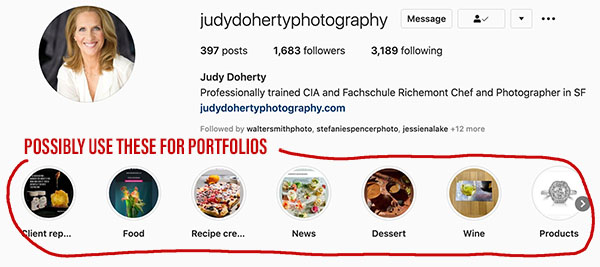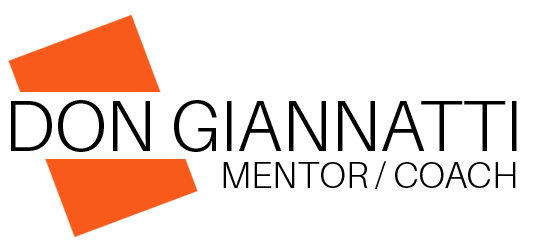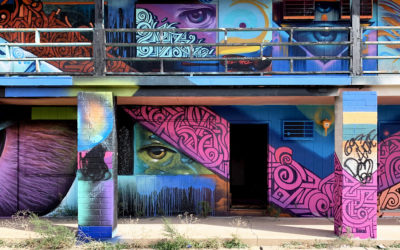A SOCIAL MEDIA STRATEGY FOR A FICTITIOUS PHOTOGRAPHER
My friend recently asked about what social media platforms work better for ‘photographers’ on Facebook?
And that is a question a lot of commercial and editorial photographers are asking these days. In many cases they feel like they have ignored it for far too long, and now it is time to “get serious about my ‘gram’ dudes”.
And in some ways that is very true, and in other ways it is simply too late for Instagram and getting the kind of traction those who were early adopters received. There is far too much signal there to be heard above.
But ignoring it is a very bad idea.
Yes, you should have an Instagram account.
No, you should not expect a single thing from it.
You need it for those clients who – upon hearing your name or seeing a post with your name will go to the simplest and easiest way they know to see your photography… Instagram.
Facebook is the king of social media, at this writing, and it is not worth much effort as a commercial photographer… although I would never say to not bother. As a walled garden, only those signed into FB can see FB. That limits your ability to gain reach.
Walled gardens are quite popular, and they proliferate around the free content they receive from the people who share their work and ideas there, but you have to look at the reasons people sign up to get a sense of context.
Art Directors, Designers, Creative Directors, Producers, Editors, and Agents do not sign on to Facebook to find photographers. They may want to hang with buds, or discuss their recent fishing trip, or maybe even to argue with anonymous asshats over whatever can be argued with.
But they are NOT going there to look at or for photographers.
Instagram IS a photo sharing site where the whole idea is to look at photographs, and the AD’s, CD’s, Designers et al DO go there to look at photographs.
However a good many go there to share THEIR work more than to explore for new talent. It used to be easy to look for photographers and genres and such on IG, and now it is a pain in the arse. So it is NOT a place where the vast majority of AD’s go.
Various other places like Tumblr, 500 Pix, and Flickr are marginal, at best. Those are where other photographers hang out. If you want to impress “SkippyCanonShooter” from Maine, those are the places to be.
Right now the hot places for business (if you are a commercial photographer you ARE in business you know), is Linked In, with a linked Behance account.
I wrote a short post on his wall that was something like this:
First, you have to understand the ecosphere. Above is a 10 Best article that makes no context call. Without context, there is no best.
Most of those sites are for hobbyists, consumer photographers, and the wannabee crowd that makes up most of social media.
As a commercial photographer, you must look at context and demographics. If you just want to ‘share’ photographs then it really doesn’t matter.
But if you are trying to interface with possible clients, then you have to figure out a strategy.
And on top of that, if you are not going to engage with the people on the sites, then it will be of limited success… if any.
For commercial – in order:
Linked In. +Behance
Instagram
YouTube
TikTok
Medium
Facebook is worthless for commercial work, as is Twitter, but there can still be an outside chance of engagement if you are connected with enough client types.
In order to maximize your reach, and get traction, you should be pushing all of these within the contexts of the platforms themselves.
For instance, Facebook Stories get more views than posts. Instagram stories get far greater views than feed images. Instagram Carousels get more engagement than single-image posts.
To build a strategy that is both effective as well as fun, you must approach each in their own platform style. In other words, the stuff you do for TikTok will not be the same as you do for Linked In.
Some of the platforms call for on-going engagement, and some can be used for archives. For instance, you can do a couple of YouTubes of portfolio work, BTS, or story shoots, and they can live and be valuable for a long time. TikTok requires a constant stream of content in order to be relevant.
I decided to do a sample Social Media Strategy approach for a fictitious photographer named Edward Haskell.
BIO:
Edward Haskell is a lifestyle and outdoors product shooter living in Maine. He does travel, outdoors sports equipment (skis, backpacks, boots, etc…), outdoors lifestyle (hiking, kayaking, skiing, etc…), people on location, and landscape photograph with an emphasis on outdoors lifestyles.
Strategy:
Linked In: Get involved with all the groups that are focuses around outdoor sports, lifestyles, and products. Weed out the ‘salesy’ ones and become a participant. Offer solutions, share stories (of how you saved your client’s bacon, how you found a solution to a tricky location) and more.
Stay active to 10 – 20 minutes per day.
+ Behance: Linked In has terrible image presentation so they have partnered with Behance to provide galleries and images for your visual portfolio. Use this to advantage by rotating images in and out of the Behance gallery you have linked to your Linked In page. Keep 30 images on that page, and rotate out 20 per month, making sure to catch the remaining 10 in the next rotation. No one has to see ALL of your work, they can go to your website if they want a deep dive, so show only the best work across your genres.
Develop the pages, then spend 1 – 2 hours per month sorting out and posting/deleting images.
Pay special attention to the daily post for “works in progress” – like Instagram it is a feed. This can be used for showing what you are working on from a specific shoot, to a composite, pre-planning, location scouting, casting… so many of what we do as a pro that are interesting to clients. Let them see behind the curtain and be entertained and inspired.
Behance Strategy: Keep the images there as fresh as possible and rotate them out as new work comes in. Think of having only two galleries there, “New Work” and “Impressions of Maine” which can be drawn from personal projects and local work. New work is whatever project you have undertaken and completed, although ‘drop and pops’ for an online store may not be appropriate. Behance is the best of the best, so keep the quality at the highest level. This is in addition to the gallery for your Linked In profile.
Develop the pages: then spend 20-30 minutes loading up new images and removing old ones when appropriate. Hint, as soon as they are finished is a good “appropriate” time.
STORY: THE MOUNTAINS.
CLIENT: SELF ASSIGNED
LOCATION: THE BEAVER MOUNTAINS
Show the five images we have chosen in this project on Behance.
Instagram Strategy: Choose a niche, and aesthetic, or a presentation style that works for you there. Perhaps mountain climbing (and skiing) becomes the focus. Show relevant images from the current season, or change it up to doing the alternate seasons (skiing in the summer, rock scrambling in the winter…). Whatever you do, you absolutely must have a theme on your Instagram. Details of a mountain ascent, with maps, graphics, text, and fellow climbers can be used to make Instagram Stories… many more views that feed posts. Add video, graphics, audio… make them be a running commentary or a set of collected experiences that can run for a day or a week. Adding to stories should be scheduled into your day.

Instagram ‘tabs’: You can create archives of images, stories, genres, or whatever ties your image together with this relatively new feature. Look at the top of many of the popular IG’ers and you will see that they have archived some works into several ‘tabs’… could be a great place for portfolio work to live.

Engagement: If you do not interact with those who want to interact with you, you will simply be an archive. If you want to be engaging, you must engage. There are many online gurus who will tell you all about the same information. Respond to messages, send messages to those appropriate and of interest to you, and look for brands and clients to interact with. I cannot tell you how many of my Project 52 photographers have gotten work from Instagram.
But there’s a catch. They didn’t get that work simply because they had images there to share. They got it because the engaged brands, art directors, and clients directly to share ideas, images, and ask for opportunities.
Use an uploader like “Later” and do all the months uploads in an hour or so. Then hit IG for 10 minutes in the morning and 10 minutes in the evening to check-in with comments, look for brand opportunities and engage people who may be good to engage with.
YouTube Strategy: YouTube is the biggest social media platform in the world – or at least it is close. This is where people SEARCH for inspiration, search for solutions, search for photography-related subjects.
You may not want to be a “YouTuber” and that is fine, but you should have a presence there. Perhaps all you do is bundle your portfolio tabs into short ‘video slide shows’ with music and a couple of ‘contact me’ panels. Or show the images from a recent personal project with audio. Or have someone make some video of you doing something really spectacular.
Ignore YouTube at your own peril.
Spend an hour or so per month to create a monthly upload.
Here is a simple example. Do better.
TikTok Strategy: Show quirky videos, stills, images, signs, stuff you find funny, and other off the wall, NON-commercial content… but be very careful to look for a niche. Perhaps it is funny people skiing, or the different ways people get on or off a lift, or the crazy stuff that happens on a hike… whatever it is, it must be very ‘poppy’ to grab attention.
I suggest you spend some time on TikTok… I am not familiar enough with the technical side to share much… video, music, and audio.
Medium Strategy: Write one long-form (1000 – 1200 words) about a recent shoot, personal project, piece of special gear, a robust visual solution… whatever. Add 8 – 10 images, and post it on Medium. Build a channel by consistently posting at a specified interval. Once per month is fine. This can be quite personal or it can represent something you feel strongly about. Here are a few: Lobster fishermen, isolated winter towns, summers on the beach, lighthouses with a twist (photographed from your Kayak perhaps), performance artists in Maine… there are a lot of angles there.
Obviously, this is more focused on editorial, but editorial leads to advertising.
Spend whatever time it takes to write and edit the images. OK to do ongoing projects, short vignettes of several projects, or just an off-the-cuff article on some images you took a week ago. The important thing is to keep the writing brisk, the images amazing, and the post time as consistent as possible.
In total that is a lot of content to be created, but actually, it is pretty much the same content spread across different mediums to be seen. The images that are going into your Instagram may simply be outtakes from a job you did or a project you are working on. Those same images are then rolled into a Medium article, separated for an Instagram
Yes, the world – especially the world of marketing – is driven by content creation, and the best content wins. Whether it is a high-end Scotch or a bargain set of luggage, the content created around those items can make or break any sales-driven agenda.
IMPORTANT NOTE: YOU DO NOT HAVE TO DO ALL OF THESE. PICK THREE, FOCUS ON THEM, EVALUATE AFTER 6 MONTHS.
Then either change approaches, or change frequency, or change the content style. You have to give it some time so you have enough data to see what is working. And, BTW, you must work your butt off to make as many people aware of what you are doing as possible. Yes, it’s a lot of work. But it is the work we must do.
Protected: DURANGO 10-26-2021: CHOOSING A PROMOTIONAL MEDIUM
Password Protected
To view this protected post, enter the password below:
Protected: DURANGO: 10-19-2020 : PROMO PREP TIME
Password Protected
To view this protected post, enter the password below:
Protected: DURANGO 10-12-2021
Password Protected
To view this protected post, enter the password below:




